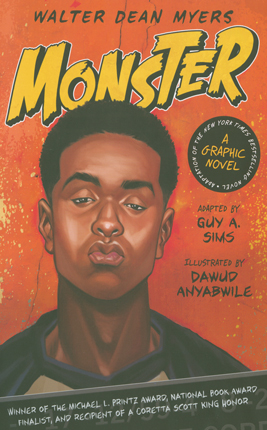Full Text Reviews: School Library Journal - 08/01/2015 Gr 9 Up—This is the story of a teenager named Steve Harmon who is on trial for murder and robbery, but it is not clear if he's guilty or not (in part because we see the story through his eyes, and he is reluctant to admit the full truth). Steve is interested in film, and so much of the story is told in a screenplay format. The screenplay idea worked well as a novel in the source material, and the format was noticeable enough that it jumped off the page and readers could clearly understand what was going on in Myers's Printz-winning Monster (HarperCollins, 1999). But this graphic novel adaptation is clunkier in its attempts to use this same format. Steve shares that he wants to make this story into a movie, and then readers are presented with traditional words and images often depicted in comics, which may confuse teens about whether they are seeing the movie idea or just the graphic novel format. Anyabwile's black-and-white artwork will give this tale added visual appeal, as the scenes portray the action takes place from different characters' points of view, as well as close-ups of conflicted emotional expressions. VERDICT This graphic novel adaptation will introduce this story to a new generation of fans, but unfortunately it does not maintain the strength or the style of the original novel.—Andrea Lipinski, New York Public Library - Copyright 2015 Publishers Weekly, Library Journal and/or School Library Journal used with permission. Booklist - 08/01/2015 *Starred Review* Myers’ award-winning 1999 novel was a bold experiment in form, telling portions of the story in, among other things, a screenplay. African American teen Steve Harmon is a burgeoning filmmaker, and his interest in cinema shapes his account of being on trial for his role in a robbery that resulted in murder. Steve’s story would be dramatic in any format, but this graphic adaptation is particularly well suited to the tale. Told as a trial with flashbacks to the robbery and moments in the lives of those affected, Sims’ adaptation, aided by Anyabwile’s ingenious black-and-white comic-book-style sequential art, perfectly captures the natural suspense of a courtroom drama. Using panels like a filmstrip, Sims and Anyabwile achieve several remarkably cinematic effects: alternating grids and splash pages captures the tension between close-up and long shots; the use of jittery lettering and uneven word balloons injects deeper anxiety into the “sound design”; having a jury view the events recounted in testimony as a movie audience creates incisive visual metaphors. Though this graphic adaptation requires close and focused attention to unpack at times, the superbly rewarding format serves to powerfully emphasize Myers’ themes of perspective and the quest to see one’s self clearly. A must-have for public and school libraries, and a standout graphic novel. - Copyright 2015 Booklist. Loading...
|



